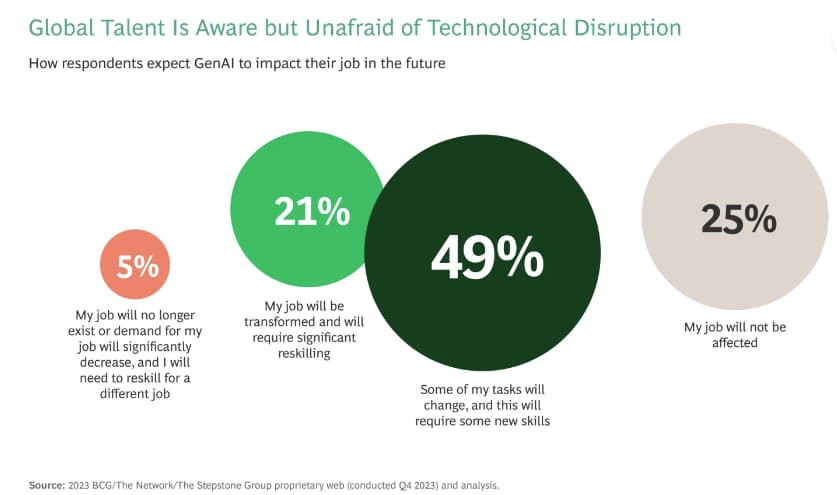The impact of technology in the workplace is constantly changing. Think about this: Almost all employed Americans have email accounts, many provided by their employers to build connections and help them perform their jobs. It’s become an employment expectation. According to the Pew Research Center, more than three-quarters of people with work email say the tool makes it easier to keep up with work.
However, as email became prevalent in the ’90s, employers, HR leaders and employees were likely unsure how the new technology would change the workplace. It’s an example of how tech goes from cutting-edge to commonplace.
Today, employer focus is on artificial intelligence and how this latest wave of HR tech will influence workplace priorities. What do employees expect to gain from their employers regarding access to gen AI and other ultra-modern tech solutions?
The June 2024 Decoding Global Talent survey, conducted by BCG/The Network/The Stepstone Group, shed some light on this question. This annual study provides insights into worker priorities and perceptions from more than 150,000 people across 188 countries. The report demonstrates that the things that matter most to employees are shifting, and employers who meet workforce expectations will be better positioned to attract and retain talent in the global labor market.
Gen AI and job security
For the first time in the 10-year lifespan of the Decoding Global Talent survey, job security emerged as the top workplace priority among respondents. BCG researchers suggest that this increased focus on job security may be due to industry restructuring and heightened geopolitical uncertainty, some of it around AI. While the impact of technology on jobs is not new, the disruptive potential of gen AI is affecting a wide range of sectors, influencing not only repetitive tasks but also the potential for creative and conceptual work.
Interestingly, gen AI adoption varies by location. According to the BCG survey, nearly 40% of respondents use gen AI tools regularly, with higher adoption rates in emerging economies. This trend persists even when controlling for age, profession or industry. High-income economies like Switzerland, Australia, Estonia and Singapore also show significant gen AI adoption rates. At the same time, European and Middle Eastern countries lag, perhaps due to stricter regulations and perceived risks.
Matej Hrapko, a long-time Decoding Global Talent interviewee from Austria, likens the gen AI movement to past technological shifts, such as the transition from landlines to mobile phones—he says there is a need for constant adaptation.
While more than 70% of respondents anticipate that their jobs will change, requiring them to develop new skills in the face of gen AI, the good news is that a very small segment (5%) expects to lose their jobs or face a significant lack of demand for their employment.
The survey reveals that workers are increasingly seeking jobs offering both job security and learning and development opportunities—two factors that are becoming more parallel to each other. According to the study, most workers recognize the necessity of understanding which skills to build to stay competitive, and they realize not doing this could cost them work opportunities.
Is HR responsible for tech-centered learning investments?
HR leaders must build their organizations’ capacity to develop new skills at a much larger scale and a much faster pace than is currently possible today, says Orsolya Kovács-Ondrejkovic, associate director of people strategy at BCG. “This requires significant investment in learning—more than what most companies currently dedicate,” she says.

To bring this resource to scale, HR leaders should position tech-centered learning programs as assets that pay off rather than expenses. However, communicating this to the C-suite and other executives remains challenging for many CHROs.
However, as long as these budgets are considered costs rather than investments, according to Kovács-Ondrejkovic, they’re likely to receive lower priority than other financial commitments. This perspective may limit the strategic value and long-term benefits companies could gain from enhancing employee capabilities.
Plus, another roadblock demonstrates the value of educational programs: “Most employers still have a long way to go in terms of collecting data and calculating the return on investment when it comes to learning,” according to Kovács-Ondrejkovic.
Employers also face a complex challenge in attracting and retaining talent, which becomes more complicated when considering how to satisfy the workforce’s thirst for new skills, training and development opportunities. Kovács-Ondrejkovic emphasizes that this will require a paradigm shift in how employers approach corporate learning.
HR leaders must anticipate technological impacts on their workforce and offer reskilling programs to help employees stay competitive. The survey shows a willingness to reskill among 57% of respondents, particularly those with lower or mid-level education; meanwhile, older individuals are generally less open to reskilling.
Hrapko, the long-time survey participant, personifies this perspective: “I’m still fairly young and able to learn this new technology now,” he says. “For the next [tech shift] that will come, I would probably have more trouble.”

Stepstone Group
Are employers lacking in developing workforce skills?
A separate survey conducted by the ADP Research Institute, titled People at Work, complements the findings that employees value job security and want employer-provided growth opportunities. The ADP report offers a detailed look into workers’ sentiments regarding career advancement, skill development and the impact of artificial intelligence on job security. The ADP survey gathered responses from 34,612 workers from 18 countries across various regions in Latin America, North America and Asia Pacific.
A significant finding from the ADP survey is the perceived lack of employer investment in skill development. Less than half of the workers surveyed feel their employers contribute to the skill growth they need to advance their careers. Nearly half believe that future skill sets will require technological knowledge that is not currently necessary in their jobs.
The ADP survey also delves into workers’ views on AI and job security, revealing that 43% think having AI on the job will be beneficial. Those who believe AI will make their work easier by saving time daily are less likely to feel insecure about their jobs compared to those who are unsure about how new AI tools will influence their workday.
According to ADP, confidence in career advancement appears linked to perceptions of AI, with 60% of workers believing they have the skills to advance to the next job level within three years. This is particularly relevant when employees believe they’ll develop new competencies through their workplace. Among those expecting regular AI assistance from their employer, 70% are confident in their skills for career advancement.
Both surveys highlight the changing priorities of workers and the fact that learning is now expected as part of employment benefits. “Our data clearly show that job seekers look for employers that help them build and maintain future-proofed skills,” says Kovács-Ondrejkovic. “Having robust learning and development offerings is no longer nice to have, but a major deal breaker.”
The post Is HR doing enough to invest in tech-centered learning? appeared first on HR Executive.